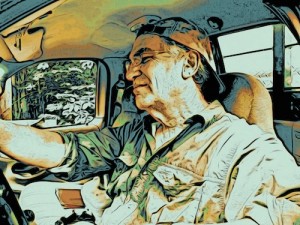From the Archives: Ancient Ramp Construction

My good friend Jeff Mann, the true Yard Ramp Guy, has asked me to revisit some of my original contributions. And so: my From the Archives series. This week I explore the earliest civilizations that built with⏤ surprise ⏤ ramps.
Information on the Internet about the construction of the great cities and monuments of the Mesoamerican and South American cultures is surprisingly hard to find, it turns out.

Not So Ancient: Me
The Aztecs were real tricky to find stuff on. Almost every supposed "source" detailing its construction techniques immediately starts going on about how they sacrificed people during construction, then doesn't bother to actually discuss the techniques they used. I'm no trained historian, but that seems like sensationalism to me, and it sure doesn't answer my questions.
There are a few interesting tidbits out there, though. Teotihuacan, one of the major Aztec sites, was actually constructed over a thousand years before the Aztecs gained power, by someone else entirely.
The Inca and Mayan empires have a bit more out there to easily find. I had to dig through a lot of nonsense about Mayan prophecies and their mass disappearance, but there was a lot of good stuff. Like this: They actually used a primitive form of limestone-based concrete for much of their construction.

One Small Step for a Spring Chicken
The Incans were the easiest to find information on, since most of the stuff on the Internet is about their construction techniques anyhow. Their buildings were famed for being constructed of huge stone blocks in irregular patterns that for together perfectly, without gaps. You can't even stick a knife between the stones.
People go crazy over that, some even going so far as to say that there were aliens helping the Incans. (Some nuts out there.) I think it says more about contractors today than it does about ancient construction. Tight seams just take good workmanship.
The stones in Incan constructions were placed by dragging them up huge earthen ramps on log rollers. Interestingly enough, they took the opposite approach to the ramps than the Egyptians, who just put together giant straight ramps. The reason they could do that when the Egyptians couldn't is pretty simple: the Incan Empire was huge. It was basically the Rome of South America. It could afford to just throw manpower at problems until they were solved.
They did save a little money by using locally quarried limestone or granite, but the empire was wealthy and powerful enough that it could have shipped them halfway across Peru on their excellent system of roads if the whim overtook them. We have tons of archaeological evidence for the Incan ramps, and a few—even still—partially exist.
The Yard Ramp Guy®: (Fork) Lifting Toward 2020
This week, my friend The Yard Ramp Guy begins his blog with a quotation from Oscar Wilde. That's all I really needed. And then his blog just got better and better.
Read his consistently fine perspective HERE.

From the Archives: The Ramp Incident

My good friend Jeff Mann, the true Yard Ramp Guy, has asked me to revisit some of my original contributions. And so: my From the Archives series. This week I return to a ramp from my youth, one that taught me—the hard way—to always seek out the best quality.
I broke my first bone when I was eight. My cousin John and I had decided to build a bike ramp in his back yard. His mom was asleep, so we couldn't play inside the house, and we'd already read through his comics a dozen times before.

A Disarming Story For You
We gathered a bunch of cinder blocks and boards from the shed my uncle was building and hauled them out to the top of the big hill behind the house.
I had a brand new Schwinn, and he had one of those heavy black Raleigh bikes from England. The boards were resting on the cinder block at about a 45-degree angle. I went first, on account of John being quite a bit smarter than me. I moved right up against his house to get the fastest start I could. I came at the ramp straight on and made it onto the board I was aiming at, which then promptly broke in half, and I crashed full speed into the cinder blocks.
Somehow I wasn't seriously injured, beyond a couple of scrapes and bruises. We rebuilt the ramp with a much, much lower angle this time. I went first again, again proving John was (and still is) much smarter than I am.
I hit the ramp at full speed again, and this time it held. I must have launched a good seven feet off the ramp, though at the time it felt closer to a hundred. I stuck the landing and shot down the hill faster than I'd ever gone before. I would have made it all the way down, too, if it hadn't been for a cinder block that had fallen down the hill when I crashed into the first ramp. My bike flipped over it, and I landed on my arm, breaking it just above the wrist.

Both Arms Now Working Just Fine
John, meanwhile, hadn't bothered to watch me go down. When he saw me ramp, he just had to go himself. He used a different, longer board than I did. As soon as his back wheel hit the end of the board, it flipped up into the air like it were part of a catapult, flew through the air, and somehow managed to land on one end on my injured arm between the wrist and elbow, breaking it a second time before bouncing farther down the hill.
John had lost control of his bike after the failed ramp attempt. It came tumbling down the hill in loose pursuit of the board and landed right on top of me, which didn't feel too good. John was chasing his bike, but when it came to a sudden stop, he didn't, and he fell right on the bike, which forced all of that weight onto—yes—my injured arm again between the shoulder and elbow, breaking it a third time.
To add insult to injury, I got grounded for twice as long as John. There is one continuing advantage to the whole escapade, though: John always buys the beer when we go fishing. I guess he still feels a little bad.
The Yard Ramp Guy®: Ramping Up For The 2019 Holidays
This week, my friend The Yard Ramp Guy has apparently become a big fan of the IRS. I’d be concerned, though his perspective makes perfect sense.
Audit his words HERE.

From the Archives: Those Star Ramps

My good friend Jeff Mann, the true Yard Ramp Guy, has asked me to revisit some of my original contributions. And so: my From the Archives series. Back again to ramps, one of my favorite inventions...
I never really watched much science fiction as a kid, but my boys loved it. Dragged me to all those Star Wars movies, always had Star Trek and all those other space shows on  the TV. I can't say as I'm a huge fan now, but I can definitely see the appeal. (Except for robots. We've already lost enough jobs to them; manufacturing lines hardly even need people anymore.)
the TV. I can't say as I'm a huge fan now, but I can definitely see the appeal. (Except for robots. We've already lost enough jobs to them; manufacturing lines hardly even need people anymore.)
Something always bothered me about a lot of those movies, though, and I only recently figured out what.
In Star Wars, when they want to travel between ships they climb the ramp into a shuttle, raise the ramp, fly over, lower the ramp. When they're delivering cargo, same thing. It makes sense.
In Star Trek, though, they have teleporters, and they use them all the time. I don't know if that stuff is possible, but it just nagged at me until I realized: they're basically like lifts.
When you're loading or unloading something, a ramp is almost always going to be cheaper, easier, and faster. Not always by much, but it will be. Less upkeep, too.  I don't know how much power teleporters use, but I feel like it can't be cheap to run one. Plus, the teleporters come out in those nice, carpeted rooms. They can't possibly load all their stuff from there. There'd be marks all over the carpet.
I don't know how much power teleporters use, but I feel like it can't be cheap to run one. Plus, the teleporters come out in those nice, carpeted rooms. They can't possibly load all their stuff from there. There'd be marks all over the carpet.
Since they have imitation gravity on those things, why don't they just lower the gravity there and push them up ramps like they're full of feathers? Heck, you'll be saving on power this way.
I know I'm being nitpicky here, but it kinda feels like the writers on the show assumed that technology would get rid of the need for logistics. You're always going to need to load and unload things, no matter how many years in the future you are and, if you ask me, teleporters aren't going to replace ramps anytime soon.
The Yard Ramp Guy®: New Forklift Ramp Q&A
This week, my friend The Yard Ramp Guy answers three essential questions that I'm predicting will have you seeking a new forklift ramp from him in record time.
Click HERE to read all about it.

From the Archives: Ramps, Allium & Google

My good friend Jeff Mann, the true Yard Ramp Guy, has asked me to revisit some of my original contributions. And so: my From the Archives series. Back now to ramps, one of my favorite inventions...

Wild Leeks
You know the first thing I see when I Google "ramps"? (Ignoring those constant ads, of course). A Wikipedia article on ramps. It's a pretty well researched and detailed article, too, listing all sorts of uses for ramps, their discovery and history, even festivals dedicated to them!
The only problem, though, isn't about inclined planes. It's about a plant. Specifically: Allium tricoccum, also known as wild leeks.
So when you Google one of the most important inventions in human history—one of the basic simple machines that makes civilization work—you get a smelly weed that some people like to eat. Maybe it's just me: I think the invention that allowed us to build the pyramids is a little more important than a backyard pest that makes food smell like old socks.
At least if you search on Wikipedia itself, inclined planes are the first thing to pop up. Whoever runs that site seems to know what they're doing, unlike those culinary-minded dudes at Google. It's all that time inside, I'm telling you. It's not healthy. You need fresh air and sunlight every day, so you don't end up drooling over random greenery from your yard.

That's me, thinking about ramps.
And no, this rant wasn't inspired by the new diet Maggie is putting me on. It's a legitimate complaint. I mean, I don't mind cutting back on red meat even more. I like fish and poultry just fine. I hardly drink more than a beer or two anymore, and I've been watching my cholesterol since my bypass 15 years ago.
I really just think that it's not going to hurt me to eat proper vegetables you find in the grocery store, not expensive health food store stuff I could pull out of my neighbor's yard.
(The one without the dogs, at least. Nice dogs, but I'm not eating anything out of that yard.)
That's not the point, though. I just think that Google is doing inclined planes a real disservice.
The Yard Ramp Guy®: Success in Yard Ramp Industrials
This week, my friend The Yard Ramp Guy's big wheels keep on turning with a great riff on the importance of attention to detail.
Dig into the specifics HERE.






